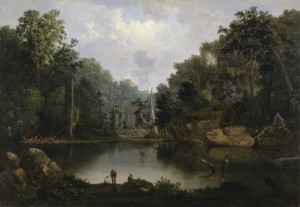-
To Decode Elephant Conversation, You Must Feel The Jungle Rumble : NPR 082015
Elephants are extraordinary animals. Their formidible size, loud stamping and trumpeting make them hard to miss. But Katy Payne discovered that an elephant’s audible calls are just a fraction of its vocabulary; an elaborate infrasound conversation goes on among the animals as well. The animals’ deep rumblings can be heard through a thick forest that might muffle higher frequency calls. Enjoy this story and its sounds on NPR Morning Edition, coproduced by the Cornell Lab: - The Tales Behind eBird’s Most Extraordinary Finds | Audubon 081815
Birders have a borderline obsessive tendency to keep records. From big days to life lists, many birders find joy in quantifying their bird-watching experiences. The citizen science project eBird, a collaboration between the Cornell Lab of Ornithology and Audubon that allows birders to track their states in real-time, harnesses this urge—with riveting results. | So here are some numbers for all of the stat-happy birders out there: Since the project was launched in 2002, eBirders have submitted records for a staggering 98 percent of all bird species that exist today. That’s 10,055 out of 10,301 possible species. In July 2014, eBird posted an article highlighting the species that were missing from their records and called for eBirders to fill in the gaps. Within 45 days of posting the article, eBird received accounts chronicling sightings of 92 of the 246 previously missing species. | These numbers are a testament to eBirders’ dedication to contributing to science and conservation. But numbers can’t tell the whole story. They don’t tell of the long journeys to remote locations and grueling hikes that went into collecting data in remote locations, or the ecstatic moments when a rare bird first comes into view. | While eBird’s data is freely available, to hear the tales behind the numbers we had to ask eBirders themselves. Here’s what some of them had to say about their rare sightings.
- eBird Status Update—Mobile and Global | eBird 081915
Thanks to the efforts of eBirders worldwide, 10,197 species are represented in eBird (98% of the world’s birds), submitted by 262,109 users from 2,774,557 locations across every country in the world, totaling 262.6 million bird observations. Almost 10 million observations were submitted in May 2015 alone. | All of this is possible because of the work of the more than 250,000 people who use eBird, and a team of dedicated volunteers who care as deeply about birds, science, and conservation as we do at eBird–there are currently 980 volunteer eBird reviewers who manage data quality worldwide, complemented by a team of nearly 400 volunteer hotspot managers. A massive thanks to all eBirders and to every reviewer for all that you do for eBird.
- Federal study confirms progress in restoring the Niagara River Area of Concern | EmpireStateNews.net 082015
BUFFALO – According to a recent study by U.S. Fish and Wildlife Service (USFWS), fish tumors associated with exposure to toxic chemicals are no longer occurring at an elevated rate in the Niagara River. Based on the study’s results, DEC is proposing to submit a beneficial use impairment removal proposal to U.S. Environmental Protection Agency (EPA). The public is invited to submit input on the draft proposal for the Niagara River Area of Concern. | “The results of this study confirm that water quality in the Niagara River Area of Concern is improving,” said DEC Great Lakes Coordinator Don Zelazny. “Based on the positive results of this study, DEC proposes to no longer consider fish tumors as a use impairment within the Area of Concern.” | Currently, there are seven beneficial use impairments that exist in the Niagara River Area of Concern as a result of chemical, physical or biological disturbances to the ecosystem. Fish tumors or other deformities are one of the impairments, based on the results of two studies conducted in the 1980s that showed higher than normal tumor rates in the river’s fish. |USFWS undertook the study in 2011 to evaluate whether fish tumors or other deformities continued to be an impairment on the U.S. side of the Niagara River Area of Concern. The study, which focused on liver tumors in brown bullhead catfish, found no significant difference between tumor rates in the Niagara River and an uncontaminated reference site, Long Point Inner Bay (Ontario) on Lake Erie. Experts commonly associate brown bullhead liver tumors with exposure to contaminants. Brown bullhead are also considered ideal indicators of local environmental conditions because they are a bottom-dwelling fish and have a limited home range. | Based on the results of the USFWS study, DEC is preparing to submit a formal beneficial use impairment removal proposal to EPA. A draft of the proposal with supporting technical information may be viewed at DEC’s website.
- Whitefish Point Unit – Seney – U.S. Fish and Wildlife Service
The Whitefish Point Unit of Seney National Wildlife Refuge (NWR) was established in 1998 with the transfer of 33 acres from the United State Coast Guard. An additional 20 acres, which included 1,000 feet of shoreline was acquired in 2012. The purchase of the additional acres was made possible by a number of private donations. | The Whitefish Point Unit is nearly 80 miles away from Seney NWR and is a stop-over for birds migrating to and from Canada.
About the Ghost Turtles
150 years after Robert Duncanson painted this luminist scene on the Little Miami River, I stood in the same spot and saw a soft-shelled turtle sunning on a snag. It slipped silently into the water when it heard me. That’s when I knew past is present and destiny, too. That’s when my vision of the Ghost Turtles began. Read more
Ecology of the Senses
 Returning to Lake Superior year after year like a migrating loon, I’ve learned the other side of a slow, uncertain process that could be called “going blind.” With the lake as my teacher, I know what lies on the other side. I call it letting go of sight. Read more.
Returning to Lake Superior year after year like a migrating loon, I’ve learned the other side of a slow, uncertain process that could be called “going blind.” With the lake as my teacher, I know what lies on the other side. I call it letting go of sight. Read more.Prayer at Big Creek
![Sandhill cranes land on Platte River sandbar roosts west of Rowe Sanctuary’s Iain Nicolson Audubon Center southwest of Gibbon, Nebraska. [Photo by Lori Porter| Kearney Hub]](https://www.ghostturtles.com/wp-content/uploads/2015/03/sandhill_cranes_kearneyhub_032015-300x225.jpg) At the threshold of consciousness, as I slipped back and forth between two worlds, I put my mind in the best place I could imagine, a marsh on Lake Erie called Big Creek. I knew I’d find cranes waiting for me. I cannot say whether I prayed for them, or to them, or with them. The cant of words doesn’t matter. I believe in the still, small voice. I believe what the poet Yehuda Amichai said. Gods come and go. Prayer is eternal. Read more
At the threshold of consciousness, as I slipped back and forth between two worlds, I put my mind in the best place I could imagine, a marsh on Lake Erie called Big Creek. I knew I’d find cranes waiting for me. I cannot say whether I prayed for them, or to them, or with them. The cant of words doesn’t matter. I believe in the still, small voice. I believe what the poet Yehuda Amichai said. Gods come and go. Prayer is eternal. Read moreFreedom to Read
![An endangered Whooping crane takes flight. Yhe large bird has a 7-foot wingspan. It is all white except for black wing tips and face markings. In this photo its long neck stretches forward; its wings sweep upward; and its black legs trail straight behind it. [Source: International Crane Foundation]](https://www.ghostturtles.com/wp-content/uploads/2023/03/Whooping-crane-eastern-ICF-080622-300x157.jpg) Whenever I hear sanctimonious pronouncements about woke, parental rights, and banning books, I think of Whooping cranes. In my family, the gawky, audacious, elusive and endangered birds are synonymous with our values about the First Amendment and the freedom to read. Read more.
Whenever I hear sanctimonious pronouncements about woke, parental rights, and banning books, I think of Whooping cranes. In my family, the gawky, audacious, elusive and endangered birds are synonymous with our values about the First Amendment and the freedom to read. Read more.Sister, Teacher, Pathfinder
 A guidance counselor in high school told my sister Diana, “With your eye problems you will never make it in college. Just forget about it. Get married. Raise a family.” That advice only deepened her determination. She did it all in due time, in her own way –college, marriage, family. She became a guidance counselor herself. She certainly was the most important guide and pathfinder in my life. Read more.
A guidance counselor in high school told my sister Diana, “With your eye problems you will never make it in college. Just forget about it. Get married. Raise a family.” That advice only deepened her determination. She did it all in due time, in her own way –college, marriage, family. She became a guidance counselor herself. She certainly was the most important guide and pathfinder in my life. Read more.Flaneur & Bouquiniste
![Mark Willis peruses a 1745 volume by Voltaire at a bouquiniste book stall on the banks of the Seine in Paris. He wears a brown leather jacket and checkered flat cap. He holds the open book in his hands. Rows of old books are seen on shelves behind him. [2005 photo by Ms. Modigliani]](https://www.ghostturtles.com/wp-content/uploads/2023/03/mw_bouquiniste_05-300x225.jpg) I remember the book I held in my hands that day. I remember the feel of its time-warped, water-stained pages. I remember its murky, moldy river smell, call it the book’s bouquet, suggesting years of storage on the banks of the Seine. Had I bought it then, I could feel and smell it now and know it from a hundred other books in my library. Read more.
I remember the book I held in my hands that day. I remember the feel of its time-warped, water-stained pages. I remember its murky, moldy river smell, call it the book’s bouquet, suggesting years of storage on the banks of the Seine. Had I bought it then, I could feel and smell it now and know it from a hundred other books in my library. Read more.R & K: A Rant
 Marjorie Taylor Green auditioned for R&K’s Authoritarian It Girl at the 2023 State of the Union address. She and her Republican colleagues yelled like Tarzan swinging through the trees as they jeered and booed the President’s speech. Read Rants & Kisses.
Marjorie Taylor Green auditioned for R&K’s Authoritarian It Girl at the 2023 State of the Union address. She and her Republican colleagues yelled like Tarzan swinging through the trees as they jeered and booed the President’s speech. Read Rants & Kisses.R & K: A Kiss
 Songs by Burt Bacharach and Hal David. Singers like Dione Warwick and Dusty Springfield. What Do You Get When You Fall in Love? The Look of Love. I Say a Little Prayer. I sit in the car’s back seat and listen. I’m glad it’s dark. I’d be embarrassed if anyone could see the dreamy look on my face. Read Rants & Kisses.
Songs by Burt Bacharach and Hal David. Singers like Dione Warwick and Dusty Springfield. What Do You Get When You Fall in Love? The Look of Love. I Say a Little Prayer. I sit in the car’s back seat and listen. I’m glad it’s dark. I’d be embarrassed if anyone could see the dreamy look on my face. Read Rants & Kisses.

